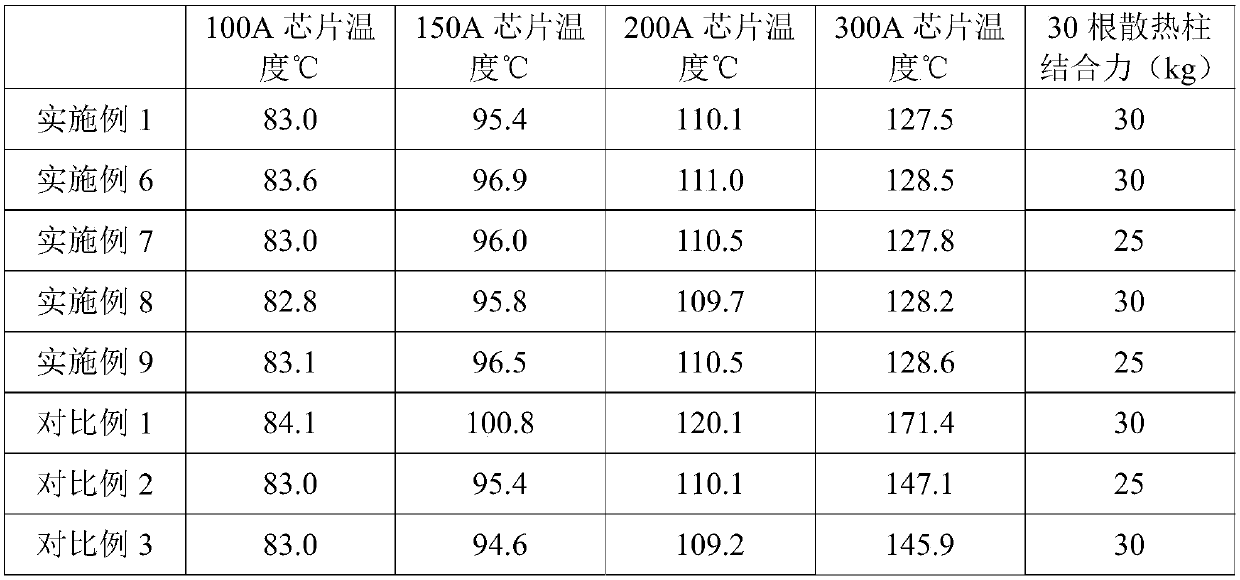Heat dissipation element and IGBT module
A heat dissipation element and module technology, which is applied in the direction of electrical components, semiconductor devices, electric solid devices, etc., can solve the problems of limiting the efficiency of cooling liquid contact heat dissipation, large mold friction, and high mold cost, so as to improve heat dissipation performance and thermal expansion. Appropriate coefficient and the effect of improving binding force
- Summary
- Abstract
- Description
- Claims
- Application Information
AI Technical Summary
Problems solved by technology
Method used
Image
Examples
Embodiment 1
[0065] This embodiment is used to illustrate the heat dissipation element of the present disclosure and its preparation method. The structure of the heat dissipation element is as follows figure 1 Shown, its preparation method comprises the steps:
[0066] 1. Air pressure casting and infiltration forming AlSiC board: use air pressure infiltration chamber equipment to preheat the SiC substrate to 500-700 °C, pour aluminum in turn, vacuumize (remove gas, prevent product from producing pores), and fill with nitrogen Pressurize (4 ~ 10MPa, to promote the aluminum liquid to fill the mold evenly) and cool down to obtain an AlSiC plate;
[0067] 2. Nickel-plate the surface of the AlSiC plate, and the thickness of the nickel layer is 12 μm;
[0068] 3. Cold-spray copper on the first main surface of the nickel-plated AlSiC plate to form the first copper-spray layer, with a thickness of 100 μm;
[0069] 4. Surface cleaning of heat dissipation column: Metal copper heat dissipation colu...
Embodiment 2~5
[0073] Using the method and materials of Example 1, the difference is that Al 2 o 3 The thickness of the copper layers on both sides of the DBC is different from that of Example 1, see Table 2 for details.
Embodiment 6
[0075] Using the method and materials of Example 1, the difference is that after step 1, the surface of the AlSiC plate is nickel-plated with a nickel layer thickness of 12 μm, and then the nickel-plated layer on the first main surface is removed by sandblasting pretreatment, The surface of the AlSiC plate is exposed, and copper spraying is carried out on the exposed surface of the AlSiC plate to obtain the first copper spray layer with a thickness of 100 μm. The structure of the heat dissipation element is as follows: figure 2 shown.
PUM
| Property | Measurement | Unit |
|---|---|---|
| thickness | aaaaa | aaaaa |
| thickness | aaaaa | aaaaa |
| diameter | aaaaa | aaaaa |
Abstract
Description
Claims
Application Information
 Login to View More
Login to View More - Generate Ideas
- Intellectual Property
- Life Sciences
- Materials
- Tech Scout
- Unparalleled Data Quality
- Higher Quality Content
- 60% Fewer Hallucinations
Browse by: Latest US Patents, China's latest patents, Technical Efficacy Thesaurus, Application Domain, Technology Topic, Popular Technical Reports.
© 2025 PatSnap. All rights reserved.Legal|Privacy policy|Modern Slavery Act Transparency Statement|Sitemap|About US| Contact US: help@patsnap.com



